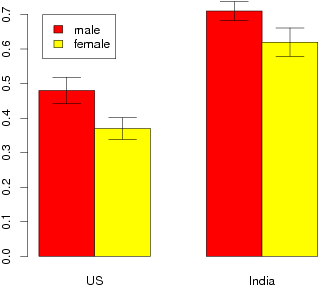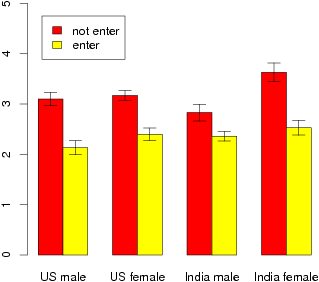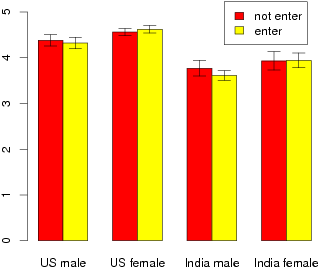
Judgment and Decision Making vol. 5, no. 3, June 2010, pp. 159-163
Emotional reactions to losing explain gender differences in entering a risky lotteryKimmo Eriksson* 1,2 and Brent Simpson3 |
A gender difference in risk preferences, with women being more averse to risky choices, is a robust experimental finding. Speculating on the sources of this difference, Croson and Gneezy recently pointed to the tendency for women to experience emotions more strongly and suggested that feeling more strongly about negative outcomes would lead to greater risk-aversion. Here we test this hypothesis in an international survey with 424 respondents from India and 416 from US where we ask questions about a hypothetical lottery. In both countries we find that emotions about outcomes are stronger among women, and that this effect partially mediates gender difference in willingness to enter the lottery.
Keywords: lottery, risk preferences, gender differences, country differences.
Why do women engage in less risky behaviors than men? Prior work demonstrates that females’ lower risk preferences and less risky behavior is robust across a variety of contexts (Byrnes et al. 1999; Powell and Ansic 1997). Of particular relevance for the current work, researchers have documented substantial gender differences in financial decisions involving risk (Barber & Odean 2001; Byrnes et al., 1999). Women, for instance, are substantially less likely than men to enter lotteries (Fehr-Duda et al., 2006). A number of meta-theoretical perspectives — from structural role theories (Eagly 1987; Eagly & Wood 1999) to evolutionary approaches (Buss 1996) — are consistent with these observations. However, only recently have researchers begun to study underlying causal mechanisms of these gender differences. There are several possible explanations of gender differences in entering lotteries. First, males and females (for whatever reason) may assign different probabilities to the likelihood of winning or losing lotteries; second, men and women may experience different (positive or negative) reactions to the benefits and costs of entering lotteries.
In a recent review of the literature on gender differences in risk preferences, Croson and Gneezy (2009) pointed to research on the tendency for women to experience stronger emotional reactions to outcomes and events than men. The authors hypothesized that a tendency for women to experience stronger emotional reactions to outcomes may explain gender differences in risk preferences. The goal of the current study is to address this heretofore untested hypothesis using a cross-national sample.
To elaborate, the tendency for women to experience stronger emotional reactions would explain gender differences in risky financial decisions, such as whether to enter a lottery, if a) compared to men, women evaluated losing more strongly, and b) the strength of negative evaluations of losing predicted decisions about whether to enter lotteries. Thus, we predict that evaluations of losing will mediate gender differences in tendencies to join lotteries.
But, assuming for the moment that females tend to experience stronger emotional reactions to all outcomes (as suggested by Croson and Gneezy), they would also experience stronger (positive) reactions to winning. Wouldn’t these stronger positive reactions offset the negative emotional reactions, creating a null effect of gender on lottery decisions? We argue that the typical setup of lotteries that assigns much higher probabilities of losing than of winning does not allow stronger positive reactions to winning to counterbalance stronger negative reactions to losing. In other words, because people know that they are most likely to lose, the expected emotional reactions to losing lotteries should be a much stronger predictor of decisions to enter them than expected emotional reactions to winning lotteries. Thus, even if we do find stronger reactions to winning and losing among women, we expect that only reactions to losing will influence decisions to play.
Results from a recent study by Harris et al. (2006) are consistent with this hypothesis. Using a sample of undergraduate psychology students, these researchers measured gender differences in stated likelihood of engaging in a variety of risky behaviors. The researchers found that, in most domains, females weighed negative outcomes more strongly than did males. Further, compared to males, females expected negative outcomes to occur with a greater likelihood. Finally, Harris and colleauges found that the evaluation of negative outcomes (as well as the expected likelihood of those outcomes) partially mediated gender differences in stated willingness to engage in risky behaviors. But, to the extent that decision-makers overestimate the likelihood of negatively valued events (see, e.g., Harris et al., 2009), we cannot know for certain whether gender differences in reactions to losing explain gender differences in lottery decisions. Thus, one goal of the current reseaerch is to make the probabilities of winning and losing known and explicit, and measure gender differences in evaluations of winning and losing under these conditions. As explained below, a second goal of the study was to offer a cross-cultural test of the prediction.
The study outlined in the section to follow tests the hypotheses using Amazon’s Mechanical Turk. Users tend to be disproportionately from the U.S. and India. Thus, our dataset allows us to test the robustness of our hypotheses using men and women from two different continents. Prior work (Hsee & Weber, 1999; Weber & Hsee, 1998) addressing cross-cultural differences in risk taking found that Americans tend to be less risk seeing than Chinese. Hsee and Weber use the “cushion hypothesis” to explain these cross-national differences, arguing that in times of financial need, decision makers in collectivist cultures can rely on network ties for help. This “cushion” or safety net thus allows for more risky behavior. Thus, we might expect to observe more risk taking among Indians than Americans. Most importantly, however, we should expect the predicted gender differences to occur above and beyond any cross-cultural differences. The section to follow outlines our empirical test.
We employed Amazon’s Mechanical Turk (AMT), an online labor market where requesters can list tasks with associated monetary rewards. Individual workers choose tasks to complete for which they are then paid. Workers can be located anywhere, but the US and India dominate. Because of the large number of individuals available to work on tasks and the low compensation levels (typically on the order of a few cents per task), the AMT is attractive as a subject pool for behavioral research. For a discussion of limitations, see Mason and Watts (2009) and cites therein.
Participants filled in a questionnaire that (in addition to questions about sociodemographic variables) contained the following scenario and questions:
Suppose you have to pay 35 dollars to enter a lottery where there is one chance in nineteen (1/19) of winning 1000 dollars. Imagine that you entered the lottery, at a cost of 35 dollars, and lost. How would you feel about the loss on a scale from 0 (neutral) to 5 (extremely bad)?Imagine that you entered the same lottery, at a cost of 35 dollars, and won 1000 dollars. How would you feel about the win on a scale from 0 (neutral) to +5 (extremely good)? Assuming that you were assured that this was a completely fair lottery (with one chance in nineteen of winning 1000 dollars), would you be willing to pay 35 dollars to enter?
984 workers at Amazon’s Mechanical Turk were recruited to participate in a at a specified compensation of $0.15. As expected from previous literature on AMT, the participant pool was mainly constituted by people from India (280 males, 142 females) and the US (176 males, 237 females). No other country or continent reached even five percent of the sample. We therefore restrict our analyses to respondents from India and the US.
In order to run regression analyses we introduced binary dummy variables Enter (0/1 for willing/not willing to enter lottery), Female (0/1 for male/female) and India (0/1 for US/India).
Table 1 presents willingness to enter the lottery and valuations of losing and winning for each gender in each country (US and India). As illustrated in Figure 1 there is a large country difference in willingness to enter the lottery, with higher entrance frequency among Indian respondents. We will therefore control for country in all subsequent analysis. Within each country, as expected, males have higher entrance frequency than females, whereas females report stronger emotional reactions to both winning and losing; regression analyses show that all these three gender effects are significant when controlling for country (Table 2 and first column of Table 3).
Table 1: Proportion willing to Enter lottery, and mean (S.E.) valuations of Badness of losing and Goodness of winning.
Table 2: Results of linear regressions predicting valuations of badness of losing and goodness of winning.
Dependent variable * p < .05, ** p < .01, *** p < .001
Figure 2: Comparison of willing and unwilling to enter lottery in their valuation of the badness of losing (by country and gender). 
Figure 3: Comparison of willing and unwilling to enter lottery in their valuation of the goodness of winning (by country and gender). 
We hypothesized that willingness to enter the lottery would be predicted by the subjective valuation of losing but not of the valuation of winning. Figure 2 illustrates that, regardless of country and gender, those who would enter the lottery gave a lower badness valuation of losing than those who would not enter. In contrast, Figure 3 shows that there is no such difference in the goodness valuation of winning.
Table 3 show the results of four probit regressions of Enter on gender (controlling for country). From Model 1 we obtain the total gender effect: the probability of entering the lottery is 9.7 percentage points lower for females. From Model 2 we obtain that this effect shrinks to 6.5 points when controlling for Badness of losing. Thus, one third of the total gender effect on Enter was explained by the gender difference in Badness of losing that we found (Table 2, first column). This partial mediation effect is statistically significant (p = .001) according to a Sobel test for a binary outcome variable (MacKinnon & Dwyer 1993).1 The last two models of Table 3 also include the goodness valuation of winning; as predicted, this variable plays no important role in predicting willingness to enter the lottery.
† p < .1, * p < .05, ** p < .01, *** p < .001
The current study replicates and extends previous work by Harris et al. (2006) to address the mechanisms underlying the well-established tendency for females to make less risky financial decisions than males. We used a cross-national sample of Indians and Americans to test a hypothesis, recently suggested by Croson and Gneezy (2009; see also Harris et al. 2006), linking gender differences in risky financial decisions to the tendency for females to experience stronger emotional reactions to winning and losing. We expected females’ stronger emotional reactions to losing (e.g., the costs of entering a lottery) to drive females’ greater reluctance to enter lotteries.
The findings strongly support the hypothesis. We observed the expected gender differences in stated willingness to join the hypothetical lottery. Further, as expected, decisions to enter the lottery were driven by the anticipated emotional reactions to losing the lottery but were unaffected by anticipated emotional reactions to winning the lottery. This is an intuitive result, given the greater chance of losing vs. winning the lottery. Finally, gender differences in entering the lottery were substantially reduced when the negative emotional reactions to losing were included in the analyses. This is precisely what the mediation argument would lead us to expect.
Note that we found a gender effect also on goodness ratings: females tended to give higher ratings also of the the winning outcome. Thus, for a lottery where the winning rather than the losing outcome is the most probable one we speculate that the gender effect on risk-taking might disappear or even be reversed.
According to our analysis, just above 30% of the gender difference in risk-taking was explained by differences in emotional reactions to losing; in other words, almost 70 percent was left unexplained. It is therefore possible that the other mechanism we mentioned in the introduction, gender differences in interpretations of probabilities, also played a role. In our lottery design the probability of winning was explicitly presented as 1/19, but it is possible (though difficult to measure) that this probability is internally represented as different subjective probabilities by men and women; indeed, subjective probabilities may even correlate with emotional reactions, as in Harris et al. (2006). We also want to suggest yet another potential complementary explanation of gender differences in risk-taking: several participants gave comments to the effect that they had committed themselved never to play lotteries, regardless of its winning scheme. Future research should control for the existence of such principles.
We also observed a strong effect of country, with Indian respondents reporting a greater willingness to enter the lottery. Although this difference is consistent with our application of the cushion hypothesis, it is inconsistent with the logic underlying the hypothesis. Namely our application of the cushion hypothesis led us to predict that, ceteris paribus, Indians will experience losing as less bad than Americans. These differences in anticipated emotional reactions to losing, in turn, would create differences in entering the lottery. However, we did not find differences by country in evaluations of losing. As an additional surprise, we found that Indians valued winning less positively than did Americans. Thus, the higher expressed willingness of Indians to enter the lottery must be explained by some other mechanisms than valuations of winning and losing, such as country-level differences in probabilistic thinking (Wright et al., 1978).
Despite the substantial differences between Indian and American respondents, we observed precisely the same pattern of findings in the two cultural groups relevant to our key hypothesis on gender differences. Given that these data provide strong support for the hypothesis across cultural contexts, we believe that a promising direction for future work would be tests of the hypotheses across other domains, such as other types of financial decisions (whether to invest in risky portfolios) or physical risks. As noted earlier, researchers have pointed to the robustness of gender differences in risky behavior across a variety of domains and contexts. Given the implications of risky behavior in both financial (Barber & Odean, 2001) and physical (Byrnes et al., 1999) domains, gaining insight into the mechanisms that lead to gender differences in risk taking could have implications for a range of practical problems.
MacKinnon, D. P. & Dwyer, J. H. (1993). Estimating mediated effects in prevention studies. Evaluation Review, 17, 144–158.
Powell, M. & Ansic, D. (1997). Gender differences in risk behaviour in financial decision-making: An experimental analysis. Journal of Economic Psychology 18, 605–628.
This document was translated from LATEX by HEVEA.